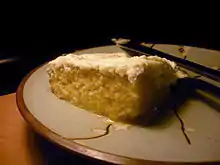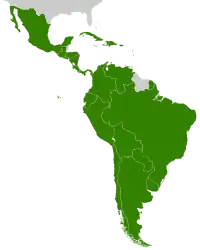
| Life in Nicaragua |
|---|
 |
| Art |
| Cinema |
| Cuisine |
| Culture |
| Demographics |
| Education |
| Holidays |
| Human Rights |
| Literature |
| Music |
| Politics |
| Religion |
| Tourism |
Nicaraguan cuisine includes a mixture of indigenous Amerindian cuisine, Spanish cuisine, and West African cuisine. Despite the blending and incorporation of pre-Columbian, West African, and Spanish-influenced cuisine, traditional cuisine differs on the Pacific coast from the Caribbean coast. While the Pacific coast's main staple revolves around beef, poultry, local fruits, and corn, the Caribbean coast's cuisine makes use of seafood and coconut.
Cuisine
Main staples

As in many other Latin American countries, corn is a staple. It is used in many widely consumed dishes such as nacatamal and indio viejo. Corn is not only used in food; it is also an ingredient for drinks such as pinolillo and chicha as well as in sweets and desserts. Other staples are rice and beans. Rice is eaten when corn is not, and beans are consumed as a cheap protein by the majority of Nicaraguans. It is common for rice and beans to be eaten as a breakfast dish. There are many meals including these two staples; one popular dish, gallo pinto, is often served as lunch, sometimes with eggs. Nicaraguans do not limit their diet solely to corn, rice, and beans. Many Nicaraguans have small gardens of their own full of vegetables and sometimes incorporate flowers into their meals.
Commonly used ingredients are peanuts, cabbage (shredded in vinegar, this is called "ensalada" and used as a side dish, sometimes with carrots and beets added), carrots, beets, butternut squash, plantains, bananas, fresh ginger, onion, potato, peppers, jocote, grosella, mimbro, mango, papaya, tamarind, pipian, apples, avocado, yuca, and quequisque. Herbs such as cilantro, oregano, and achiote are also used in cooking.[1]
Typical Nicaraguan dishes
- Arroz ancha
- Arroz aguado
- Arroz con pepino
- Arroz con pollo
- Berenjenas rellenas
- Brochetas
- Camarones al ajillo
- Carne asada
- Carne desmenuzada
- Carne enchorizada
- Carne pinchada
- Carne sofrita
- Coctel de conchas
- Corazon asado
- Costillas asadas de cerdo
- Cusuco frito y desmenuzado
- Chancho adobado
- Chancho frito
- Chicharrón con chimichurri
- Churrasco con chimichurri
- Ensalada de aguacate
- Filete en tocineta
- Gallina rellena
- Gallo pinto
- Guacamol Nica
- Guiso de berenjenas
- Guiso de chayote
- Guiso de pipian
- Güirila
- Higado asado
- Higado en caldillo
- Higado frito
- Indio viejo
- Lengua
- Lengua fingida
- Lomo de venado
- Lomo entomatado y encebollado
- Lomo relleno
- Nacatamal
- Pechuga con queso
- Pechuga desmenuzada
- Pescozon
- Pescado a la Tipitapa
- Platanos fritos
- Posta en caldillo
- Punta de Salon henchida
- Quesillo
- Repocheta
- Rondón
- Salpicón
- Sopa de albóndigas
- Sopa de cola
- Sopa de frijoles
- Sopa de gallina con albóndigas
- Sopa de mondongo
- Sopa de pastora
- Sopa de pato
- Sopa de pescado
- Sopa de punche (cangrejo de mar)
- Sopa de queso
- Sopa de res o de hueso
- Sopa de sesos
- Sopa de verduras
- Sopa siete mares
- Substancia de carne o de higado
- Tacos al pastor
- Tajadas con ensalada and/or Queso frito
- Tamal pisque
- Tamal relleno
- Tamales
- Tostones
- Vaho
- Venado asado
- Vigorón
Beverages
Refrescos (drinks)

Nicaraguan cuisine makes use of fruits, some of which are only grown in that particular region due to their location. Many fruits are made into drinks known as frescos, the Nicaraguan name for what are called "aguas frescas" in other Latin American countries. Common flavors include melon, tamarind, papaya, guayaba, guanábana, coconut, pineapple, and pitahaya. Pinolillo is very popular among Nicaraguans, as many times they refer to themselves as pinoleros, which means "pinolillo drinkers".[2] Many drinks are also made from grains and seeds, mixed with milk, water, sugar and ice.[3]
Alcoholic beverages
Rums, such as Flor de Caña and Ron Plata (both produced by Compañía Licorera de Nicaragua, S.A (CLNSA)), are both a popularly consumed beverage in Nicaragua and a crucial export product.[4][5]
Popular rum-based cocktails include the "Nica libre," a regional re-naming of the Cuba libre (itself a variation of rum and coke), and the "Macuá" (containing orange, guava, and lime juices).[6] The "Macúa" originated in 2006, when it won a Flor de Caña-sponsored competition to determine a marketable national cocktail representing Nicaragua, and was created by a pediatrician from Granada.[7][8]
Beer is also a common alcoholic beverage consumed in Nicaragua. Popular brands include Toña and Victoria, two former competitors both now produced by Compañía Cervecera de Nicaragua, as of a 1996 merger.
Other drinks
- Achiote con limon
- Achiote con toronja
- Agua de arroz
- Arroz con Pino
- Arroz con piña
- Atol
- Avena (drink)
- Avena con leche
- Avena con limon
- Cacao
- Caimito
- Cebada
- Cebada con limon
- Cebada con Milca
- Coyolito
- Chia
- Chicha
- Chicha bruja
- Chicha de caña
- Chicha de coyol
- Chicha de jocote
- Chocolate
- Ensalada de fruta
- Espinaca (made with spinach berries)
- Fresco de guayabilla
- Guabul
- Granadilla
- Horchata
- Kola Shaler
- Limonada cimarrona
- Linaza
- Linaza con tamarindo
- Mamey (nothing to do with sapodilla)
- Mamón
- Nancite (yellow cherries drink)
- Naranja con remolachas
- Naranja con zanahorias
- Papalon (beach grape drink)
- Papaturro
- Tiste
Postres (desserts)
- Almendras en miel (en jarabe)
- Almibar o curbaza
- Almibar de toncuá
- Arroz con leche
- Atol
- Atol pujagua
- Atolillo
- Ayote en miel
- Bienmesabe
- Botellitas de miel
- Brujas
- Buñuelos de yuca o platano
- Cajeta de ajonjoli
- Cajeta de coco
- Cajeta de coyol
- Cajeta de leche
- Cajeta de piña
- Cajeta de zapoyol
- Cocadas
- Cosa de horno
- Coyol en miel (en jarabe)
- Crispeta
- Cuznaca
- Chiricaya
- Dulce de leche
- Dulce de limon (cidra)
- Dulce de nancite
- Dulce de naranja
- Dulce de piña
- Dulce de papaya
- Dulce de toronja
- Dulce de remolacha con zanahoria
- Enchiclados
- Espumillas
- Gofio
- Flan
- Gofio con anis
- Grosellas en miel (en jarabe)
- Hicacos en miel (en jarabe)
- Jalea de guayaba
- Jalea de mango
- Jalea de patriotas (bananas)
- Jocotes cocidos
- Leche burra
- Maduro asado
- Maduro en gloria
- Maduro horneado
- Mamones en miel (en jarabe)
- Mazapan
- Melcocha
- Motas de atol
- Nancites cocidos
- Nancites en conserva
- Perrerreque
- Piñonate
- Pio Quinto
- Polvorón
- Raspados
- Requeson
- Sopa borracha
- Suspiros
- Toronja en miel (en jarabe)
- Torta de leche
- Tres leches cake
- Turron
See also
References
- ↑ "Try the culinary delights of Nicaragua cuisine". Nicaragua.com. Retrieved 2006-05-08.
- ↑ "El pinolero y su canción de sangre y esperanza | Maradona | Derechos Humanos. Órgano Informativo de la Comisión de Derechos Humanos del Estado de México" (PDF). Juridicas.unam.mx.
- ↑ Ellis, Stefanie. "Fritanga: Welcome to Nicaragua". STLToday. Archived from the original on 2007-11-22. Retrieved 2007-06-07.
- ↑ Dara, Jillian (16 October 2019). "Drink Like a Local: Fair Trade Rum from Nicaragua". MICHELIN Guide. Retrieved 2022-09-07.
- ↑ Webber, Jude (2015-06-26). "Nicaragua's Flor de Caña rum pays healthy dividends". Financial Times. Archived from the original on 2022-12-11. Retrieved 2022-09-07.
- ↑ Lacey, Marc (2006-10-05). "Hold the Mojito and Margarita, Nicaragua Has el Macuá". The New York Times. ISSN 0362-4331. Archived from the original on 7 September 2022. Retrieved 2022-09-07.
- ↑ "Coctel nicaraguense cumple su decimo aniversario". El Nuevo Diario (in Spanish). 22 March 2016. Retrieved 2022-09-07.
- ↑ El-Bez, Quentin (2009-02-04). "Découverte - Le Macuà¡, cocktail national du Nicaragua". Alambic Magazine (in French). Retrieved 2022-09-07.



